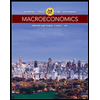
(a)
Identify the 2011 and 2012 real
(a)
Explanation of Solution
Table-1 shows the value of nominal GDP and the GDP deflator as follows:
| Table-1 | ||||
|
Nominal GDP (Billions of currency) |
GDP deflator (2005=100) | |||
| Country | 2011 | 2012 | 2011 | 2012 |
| U | 15,075.7 | 15,684.8 | 113.4 | 115.4 |
| C | 1,718.7 | 1,817.6 | 115.2 | 119.7 |
| J | 470,623 | 475,867.9 | 91.6 | 91.6 |
| I | 1,579.2 | 1,566.3 | 112.7 | 112.7 |
| A | 1,444.6 | 1,488.3 | 127.4 | 127.4 |
| UK | 1,515.8 | 1,541.5 | 117.1 | 117.1 |
The real GDP can be calculated using the formula as follows:
Substitute the respective values in equation (1) to calculate the rea; GDP of country U.
Therefore, the real GDP of Country U in 2011 is $13,294.2 billion.
Table-2 shows the value of the real GDP in 2011 and 2012, which is calculated using Equation-1 as follows:
|
Table-2 | ||||||
|
Nominal GDP (Billions of currency) | GDP deflator |
Real GDP |
Real GDP | |||
| Country | 2011 | 2012 | 2011 | 2012 | 2011 | 2012 |
| U | 15,075.7 | 15,684.8 | 113.4 | 115.4 | 13,294.2 | 1,3591.68 |
| C | 1,718.7 | 1,817.6 | 115.2 | 119.7 | 1,491.92 | 1,518.46 |
| J | 470,623 | 475,867.9 | 92.4 | 91.6 | 509,332.25 | 519,506.44 |
| I | 1,579.2 | 1,566.3 | 110.9 | 112.7 | 1,423.98 | 1,389.79 |
| A | 1,444.6 | 1,488.3 | 128.1 | 127.4 | 1,127.7 | 1,168.21 |
| UK | 1,515.8 | 1,541.5 | 115.5 | 117.1 | 1,312.38 | 1,316.39 |
(b)
Identify the inflation rate in 2012.
(b)
Explanation of Solution
The inflation rate in 2014 can be calculated using the formula as follows:
Use Equation-2 to calculate the inflation rate of Country U in 2014 as follows:
Therefore, the inflation rate is 1.76%.
Table-3 shows the value of the inflation rate, which is calculated using Equation-2 as follows:
|
Table-3 | |||||||
|
Nominal GDP (Billions of currency) | GDP deflator |
Real GDP |
Real GDP | Inflation rate | |||
| Country | 2011 | 2012 | 2011 | 2012 | 2011 | 2012 | 2012 |
| U | 15,075.7 | 15,684.8 | 113.4 | 115.4 | 13,294.2 | 1,3591.68 | 1.76% |
| C | 1,718.7 | 1,817.6 | 115.2 | 119.7 | 1,491.92 | 1,518.46 | 3.90% |
| J | 470,623 | 475,867.9 | 92.4 | 91.6 | 509,332.25 | 519,506.44 | -0.86% |
| I | 1,579.2 | 1,566.3 | 110.9 | 112.7 | 1,423.98 | 1,389.79 | 1.62% |
| A | 1,444.6 | 1,488.3 | 128.1 | 127.4 | 1,127.7 | 1,168.21 | -0.54% |
| UK | 1,515.8 | 1,541.5 | 115.5 | 117.1 | 1,312.38 | 1,316.39 | 1.38% |
(c)
Identify the country that has the highest growth rate of real GDP.
(c)
Explanation of Solution
The growth rate can be calculated using the formula as follows:
Use Equatrion-3 to calculate the growth rate of real GDP as follows:
Therefore, the growth rate of real GDP is 2.237%.
Table-4 shows the growth rate in 2012, which is calculated using the Equation-3 as follows:
| Table-4 | |||||||||||
| Nominal GDP | Real GDP | Inflation rate | Growth rate | ||||||||
| Country | 2011 | 2012 | 2011 | 2012 | 2012 | 2012 | |||||
| U | 15,075.7 | 15,684.8 | 13,294.2 | 13,591.68 | 1.76% | 2.237% | |||||
| C | 1,718.7 | 1,817.6 | 1,491.92 | 1,518.46 | 3.90% | 1.778% | |||||
| J | 470,623 | 475,867.9 | 509,332.25 | 519,506.44 | -0.86% | 1.997% | |||||
| I | 1,579.2 | 1,566.3 | 1,423.98 | 1,389.79 | 1.62% | -2.40% | |||||
| A | 1,444.6 | 1,488.3 | 1,127.7 | 1,168.21 | -0.54% | 3.592% | |||||
| UK | 1,515.8 | 1,541.5 | 1,312.38 | 1,316.39 | 1.38% | 0.305% | |||||
According to Table-4, Country A has the highest growth rate of real GDP, which is 3.592% and Country I has the lowest growth rate of real GDP, which is -2.40%.
(d)
Identify the countries that have the highest and lowest inflation rate.
(d)
Explanation of Solution
According to Table-3, Country C has the highest inflation rate, which is 3.90% and Country J has the lowest inflation rate, which is -0.86%.
(e)
Identify the country that has the most inflation
(e)
Explanation of Solution
According to the data from Table-4, Country C has the highest inflation rate, which is 3.90%. Therefore, Country C has the most inflation during 2012.
Inflation: Inflation is a sustained rise in the price level of a selected basket of goods and service for a particular period.
Want to see more full solutions like this?
Chapter 8 Solutions
Economics: Private and Public Choice (MindTap Course List)
- As indicated in the attached image, U.S. earnings for high- and low-skill workers as measured by educational attainment began diverging in the 1980s. The remaining questions in this problem set use the model for the labor market developed in class to walk through potential explanations for this trend. 1. Assume that there are just two types of workers, low- and high-skill. As a result, there are two labor markets: supply and demand for low-skill workers and supply and demand for high-skill workers. Using two carefully drawn labor-market figures, show that an increase in the demand for high skill workers can explain an increase in the relative wage of high-skill workers. 2. Using the same assumptions as in the previous question, use two carefully drawn labor-market figures to show that an increase in the supply of low-skill workers can explain an increase in the relative wage of high-skill workers.arrow_forwardPublished in 1980, the book Free to Choose discusses how economists Milton Friedman and Rose Friedman proposed a one-sided view of the benefits of a voucher system. However, there are other economists who disagree about the potential effects of a voucher system.arrow_forwardThe following diagram illustrates the demand and marginal revenue curves facing a monopoly in an industry with no economies or diseconomies of scale. In the short and long run, MC = ATC. a. Calculate the values of profit, consumer surplus, and deadweight loss, and illustrate these on the graph. b. Repeat the calculations in part a, but now assume the monopoly is able to practice perfect price discrimination.arrow_forward
- how commond economies relate to principle Of Economics ?arrow_forwardCritically analyse the five (5) characteristics of Ubuntu and provide examples of how they apply to the National Health Insurance (NHI) in South Africa.arrow_forwardCritically analyse the five (5) characteristics of Ubuntu and provide examples of how they apply to the National Health Insurance (NHI) in South Africa.arrow_forward
 Macroeconomics: Private and Public Choice (MindTa...EconomicsISBN:9781305506756Author:James D. Gwartney, Richard L. Stroup, Russell S. Sobel, David A. MacphersonPublisher:Cengage Learning
Macroeconomics: Private and Public Choice (MindTa...EconomicsISBN:9781305506756Author:James D. Gwartney, Richard L. Stroup, Russell S. Sobel, David A. MacphersonPublisher:Cengage Learning Economics: Private and Public Choice (MindTap Cou...EconomicsISBN:9781305506725Author:James D. Gwartney, Richard L. Stroup, Russell S. Sobel, David A. MacphersonPublisher:Cengage Learning
Economics: Private and Public Choice (MindTap Cou...EconomicsISBN:9781305506725Author:James D. Gwartney, Richard L. Stroup, Russell S. Sobel, David A. MacphersonPublisher:Cengage Learning Economics (MindTap Course List)EconomicsISBN:9781337617383Author:Roger A. ArnoldPublisher:Cengage Learning
Economics (MindTap Course List)EconomicsISBN:9781337617383Author:Roger A. ArnoldPublisher:Cengage Learning
 Economics Today and Tomorrow, Student EditionEconomicsISBN:9780078747663Author:McGraw-HillPublisher:Glencoe/McGraw-Hill School Pub Co
Economics Today and Tomorrow, Student EditionEconomicsISBN:9780078747663Author:McGraw-HillPublisher:Glencoe/McGraw-Hill School Pub Co Principles of Economics 2eEconomicsISBN:9781947172364Author:Steven A. Greenlaw; David ShapiroPublisher:OpenStax
Principles of Economics 2eEconomicsISBN:9781947172364Author:Steven A. Greenlaw; David ShapiroPublisher:OpenStax





